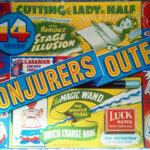I find it useful to think of performance magic props as a technology. In theatre we often talk about theatre technologies, almost always this refers to the standard, taken-for-granted elements that work together to create the theatrical experience. These technologies are often external to the actor/performer, being designed and run by technicians and specialists. Such technologies light the space, create sound, and run scenography effects. As such they create atmosphere.
In comparison to such overt technologies, the technologies of performance magic are hidden from view and are central to the magician’s performance. The technologies that powered The Phantasmagoria, Psycho, and Pepper’s Ghost would create illusionary happenings on stage that go beyond the actor-sign and blur the distinction between illusion and reality. These technologies all played in what we would broadly define as a traditional theatrical space. However, smaller props such as the pendulum are ideomotor technologies that also have a rich history in the non-traditional space, and, in particular, the séance room. Such technologies serve to deepen an audience or participant’s engagement with the séance performance.
The pendulum is a séance technology that is part of a broad continuum of technologies designed to provide evidence of spirit communication. The majority of these require the intervention of the host/medium as performer, these include, rope ties, spirit cabinets, rapping hands, and the production of ectoplasm. Ouija boards, glass moving and the pendulum are hands-off in the sense that the performer is relying on the ideomotor response of the participant to give results. These technologies in the hands of the participants, however, provide a tangible affordance of contact with the spirit realm inside the performance space of the séance.
The pendulum can also be seen as a utility prop for the séance in that falls into the category of physical phenomena. The device has a rich history outside of the séance room; a very complex example of pendulum/ideomotor action is described by Abbott (1912) in Behind the Scenes with the Mediums;
“The trick which the first medium originated I will now describe. He called it ‘The Mystic Oracle of the Swinging Pendulums, or Mind over Matter.” Briefly, it consisted in the medium apparently causing any pendulum, which might be selected from a number hanging on a frame or in a number of bottles, to vibrate or swing in response to his will. There was absolutely no mechanical or electrical connection to any of the pendulums whatever. Most of these pendulums consisted of a bullet suspended by a piece of hair wire. On a few of them glass marbles of various sizes were used instead of bullets.”
(Abbott, 1912, p. 29)
They are also featured in fiction such as the the bottle pendulums of HP Lovecraft’s Terrible Old Man (Lovecraft, 1926), or even marketed as a ‘sex detector’ see The Pendulum Knows (Spooner, 2008).
In contemporary séance practice the pendulum plays a role in establishing not only the other, but also of creating a group unity and a sense of community amongst ghost hunters. as discussed in Taylor (2011, 2015). This again promotes the ostensive state referred to by folklorists as collective delusion where an often undefined fear or panic, usually from a group of people or even a community, manifests the ostensive in group action, often magic behaviour, to reassure themselves they are acting to protect or overcome a perceived threat and thus ‘controlling their fates’ (Ellis, 2001, pp. 201–202).
Collective delusion is also a narrative process through which ostensive action is played out, the affordance of the pendulum simultaneously demonstrates group action, in that everyone can help the individual make the pendulum move; while at the same time attributing power or focus to the participant who is apparently channeling spirits. The bizarre magician appears to take the role of a facilitator to guide and ultimately elicit ideomotor response in the participant. This is then interpreted for the audience by the bizarre magician as spirit contact, or in the case of my séance practice, evidence of the most open-minded and attuned members of the audience. For example in a piece I devised with third year undergraduates the pendulums were used ludically to determine the final outcome of the performance (Taylor, 2014).
Abbott, D. P. (1912). Behind the Scenes with the Mediums. Chicago?: The Open court publishing company. http://archive.org/details/b00ehindsceneswithabborich
Ellis, B. (2001). Aliens, Ghosts, and Cults: Legends We Live. University Press of Mississippi.
Lovecraft, H. P. (1926). The Terrible Old Man. Weird Tales, 8(2), 191–192.
Spooner, W. (2008). The Pendulum Knows. Gibecière, 3(1), 50–76.
Taylor, N. (2011). Introduction. In Scripting & Storytelling for Paranormal Entertainers. Aken Productions.
Taylor, N. (2014). Vampire Survivors.
Taylor, N. (2015). Impersonating Spirits: The Paranormal Entertainer and the Dramaturgy of the Gothic Séance. In L. Piatti-Farnell & D. L. Brien (Eds.), New Directions in 21st-Century Gothic: The Gothic Compass (pp. 163–174). Routledge.

Comments by Nik Taylor